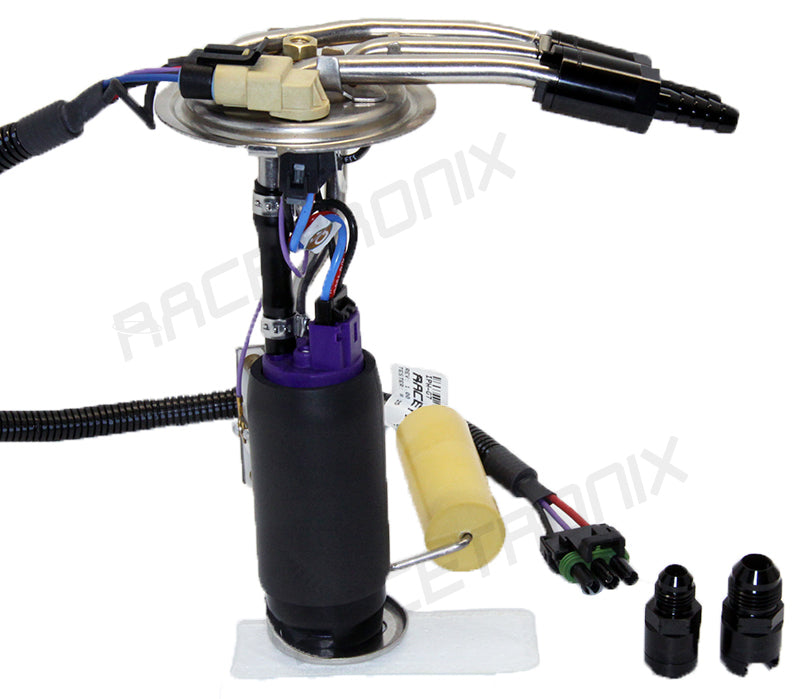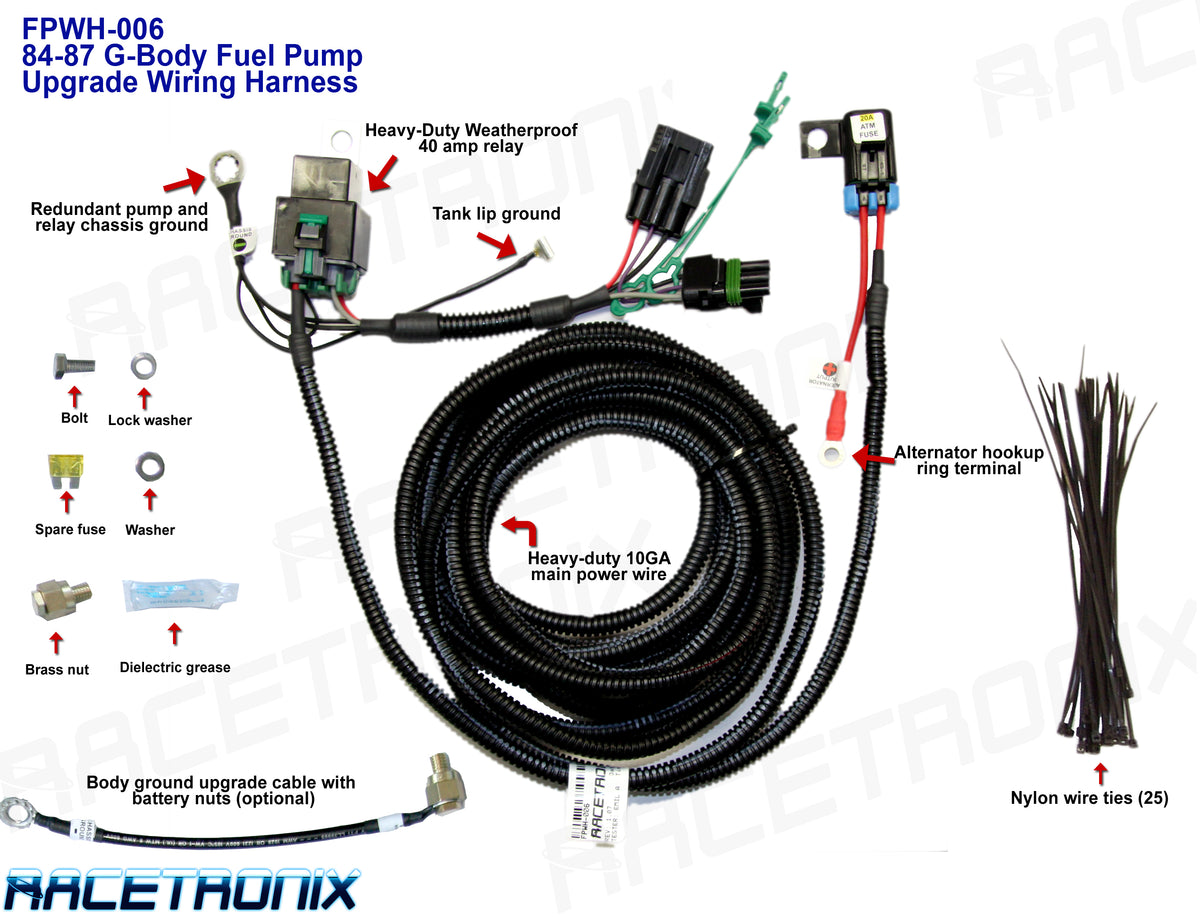No matter what, that pump needs to be removed. Then drop the tank and see what's left on the intank pump hangar.
The last step, is to order a completely new pump and hangar assembly and replace all of the rubber hose butchering you have going on with that Bosch 286 series external pump.
History time.
(Patrick get's out his favorite pipe, pulls up his ole faithful rocking chair and has a seat)
Gather round children as Patrick retells storys from years gone by...
Back before we had Walbro 340lph intank replacement pumps, the external Bosch pumps came out. This was first done with Supercharger Mustang kits from Paxton and Vortech. At the time. mid to late 90's, their solution was the T-Rex external fuel pump. This pump was smaller than the Bosch 286 and 044 external pumps and was typically installed inline on the feed line. It was used in conjunction with the stock intank pump to help "boost" the pressure. It was at best a gimmic bandaid that A LOT of racers turned to, simply because a bigger intank fuel pump didn't exist yet. Many Buick shops used this bandaid on Turbo Buicks for years, until the Bosch pumps came out. Fast fwd a few more years and Bosch came out with the external 286 series of fuel pumps. No high flow intank replacement existed yet, so A LOT of racers removed the stock pump, ran a piece of Fuel injection hose in place of where the stock intank pump used too reside and ran this pump with new fuel pump wiring. This solution, especially on Turbo Buicks lasted for ALONG time, until the release of the first Generation of the Walbro 255lph fuel pumps. Which, at the time were the best solution. Not long after this, Red Armstrong of Quad air debuted the Double Pumper setups. Twin Walbro 255lph pumps on a custom hangar. And A LOT of Turbo Buick racers went this way. Ffwd again and companies like Aeromotive started coming out with dedicated external fuel pumps that out flowed the single Walbro 255lph pumps. A lot of Turbo Buick racers switched over to these when they first came out. Unfortunately what was not known at the time, was this. Although these fuel pumps were designed to move a lot of fuel volume at relatively low fuel pressures, their volume dramatically dropped off as the pressure increased. You have to remember, this was before XFI 2.0, TurboTweak chips and Holley systems existed. Back then we had Accel DFI, Fel Pro systems and various Buick vendors stock computer chips to choose from. The "tuning" options were slowly developing with time. And the fuel system components were even slower to be developed. About this time, Steve Yaklin came out with the Maximum Effort computer chip that gave the racer 7 different tuning settings. Then Caspers came out with their Ultrachip. Which was a similar design to the Maximum Effort. Red Armstrong had his custom chips, Joe Lubrant had his custom chips, Conley's had their chips, Modern Musclecar had theirs, Caspers had theirs, Jay Carter had his, ATR, Dynotech, Hypertech, so on and so on. All of them took countless hours to develop tunes that helped keep these cars alive with the very limited fuel component solutions that we had to work with. Literally thousands and thousand of tunes and hours were spent perfecting these chips. Many cars out there still run them today.
Around the late 90's to early 2000's, the Walbro high pressure 340lph pump came out. Now we had a true drop in replacement pump that could reliably support 600 fwhp with the right injectors and chip. Shortly after that, larger high impedance injectors came out from Delphi and Siemens, namely the 50#ers and 60#ers. This allowed the average user to run a stock computer and a stock MAF sensor with the larger injectors and start making very good power without the fear of blowing a head gasket from fuel starvation. Given, there were some early setbacks with the 340 series of pumps that were addressed by many vendors. And that was a HUGE debacle that was ultimately Walbro's fault. It did wind up costing many racers a lot of money in costly engine failures. Ffwd again to the mid 2000's to early 2010's and the Walbro high pressure 340 lph pump was proven. Double pumpers were available and pushing these cars further and further up the HP ladder. So much so, that you start to see racers with big external pumps start to switch back to intank solutions for a much simpler install and less plumbing. Ffwd again and we have much larger intank pumps to choose from, Walbro, Racetronix, FORE etc, etc, as well as more modern external pumps like Magnafuel, Aeromotive and Weldon. And then, not too long ago BOOM! The Hellcat 525lph pump becomes available. Now, with a simple drop in replacement single or double pumper setup combined with the new hangar, some adapter fittings and upgrading your feed and return lines, as well as the fuel rails, you have plenty of fuel system to support 1000+ fwhp with huge fuel injectors and multiple engine management computer systems to choose from. Now, I'm sure I've forgotten some of the history, but this is a 15k foot view. It's amazing how technology has evolved over this roughly 37 year period. Some of which I lived through. These are what I like to call, the dark times. I remember what it was like not having easy upgrade options to choose from like we have today. Those were tough times... The dark times if you will...
My progression with fuel systems is this. On my 1st car, "86 T-Type "RU", (circa 1994), was the stock intank pump with adj fp regulator and hotwire kit. A few years later I upgraded to a Bosch 286 external pump with no intank guts and a simple piece of fuel injection hose dangling inside the tank, ziptied to the pump hanger, feeding through stock lines, stock rail with the same adj fp regulator. Then when I dropped in an Eastern Performance built 109 girdle motor, I upgraded to a stock tank that had an external sump welded to the bottom with nothing inside it, no internal baffle, -10an feed line into an external filter, then into a Paxton external pump (later we found out it was the same as an Aeromotive A1000 pump) out of that into another post filter, -10an feed line up to a modified stock fuel rail that had a -10an male adapter fittings brazed to the stock rail, that had the fpr mount cut off and another -10an male fitting brazed in place, -10an line run over to a Paxton external universal EFI fp regulator mounted on the inner fender, with a -8an line back to the top of the tank. I ran a flow matched set of 83# injectors with a modified stock computer and a Maximum Effort chip. A couple years later when I dropped the 274ci Stage 2 in the car, the pump got replaced with a Weldon DB2015a external pump with fresh wiring harness. That was the fuel system that was on my grey car RU when I sold it in 2005. I really hate to think about all the money I put into that car over the years.
Meanwhile, during that same time of hot rodding the grey car, in "98 I scored my white "87 T Limited for a smoking deal. It had stock fuel lines, adj fp regulator and a Bosch 044 external pump with no intank that worked well into the 11.ohs at 120 maxed out on a stock computer with a 42.5# "009" injectors with a Maximum Effort chip in 1999. It was a nice daily driver setup.
Ffwd again to 2007 and I scored my Blue "87 T "Sarah". I upgraded the injectors and chip and left the rest alone that Steve (previous owner) had installed. It had all stock fuel lines with an adjustable fp regulator, 60# injectors, TurboTweak v5.7 chip, a single Walbro 340lph pump and a hotwire kit. From 2007 until just recently when Damon (Current owner) upgraded the fuel system to support his 9 second goals.
And finally, on my current "87 GN "Legend" it currently has a single Walbro 340lph pump, -8an feed and -6an return lines, Accufab adj fp regulator with adapter fitting for the -6an return line and 80# injectors with a v5.7 TurboTweak alky race chip and Julio's Alky Control single nozzle alky kit. I will be upgrading to a Hellcat pump assembly with a new hangar, adapter fittings and HD hot wire kit from Brad at Boost Crew Motorsports very soon. This with my 80#ers will definitely be enough for my piddly goals with the car.
So, long story short just to recap. IMHO, the external Bosch style pumps, as mentioned earlier, are a mid to late 90's bandaid solution that has no business on one of these cars in 2022. The 286 and 044 Bosch external pumps did work good back in the day when setup correctly. So much so, that you would see triple pump setups on drag cars in Japan in all of the tuner magazines making 1000 hp back then. Extremely complex fuel systems for what they were. Here in the US, these pumps eventually started to fade away as vendors stopped carrying them when better, higher flowing solutions because readily available.
Anywho, thanks for listening/reading and sorry to get so long winded.
I'm sure a lot of the OG guys on here can related to this.
(Patrick get's out of his rocking chair and heads to bed)
Patrick


